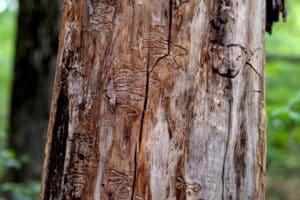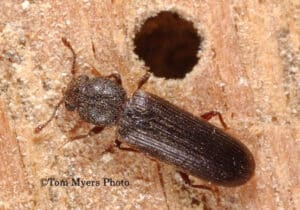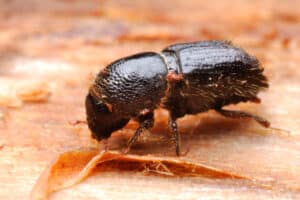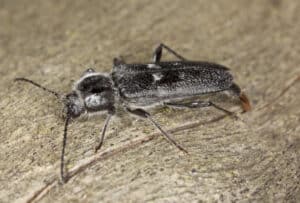
What’s Eating Away the Wood in Your House: Common Types of Wood-Boring Beetles
May 19, 2023
By Daniel Baldwin, BCE, CCFS, CP-FS
Wood-boring beetles are invasive pests that weaken wooden structures in and around your home. These insects eat wood slowly as they burrow in and out of the holes and tunnels they create. Learn how to identify the most common types of wood-boring beetles that can damage areas of your house, dig holes in your furniture, hardwood floors, and trim, and potentially cause structural harm to wood beams.
What are wood-boring beetles?
Wood-boring beetles are species that survive by eating wood. Both wood-boring beetles’ larvae, called woodworms, and the adults get their nutrition from either new or old hardwood and softwood materials. Wood-destroying beetles feast on different types of wood, depending on the species.
Some of the more common types of wood-boring beetles differ in the kinds of wood they typically infest. While some are known to mainly live on dying or diseased trees in forests or lumberyard wood, other species are more often found in homes, where they feed on furniture or other wooden surfaces.

What are the signs of wood-boring beetles?
You may spot adult beetles crawling or flying in or out of holes in wood structures. It’s rare to see the more immature forms of this insect, as they don’t emerge from inside the wood until they’ve reached the adult stage of life.
Some signs of wood-boring beetles include:
- A powder-like trail made up of wood fragments and excrement left inside or around holes in wood
- Small holes and tunnels in wood furniture and other structures
- Wood that has unexplained stains or blisters, indicating larvae are burrowing below the surface
- Clicking or tapping sounds, a sign of larvae chewing on wood
Common types of wood-boring beetles and how to identify them
The specific type of wood-boring beetle that’s infesting your home can be a little difficult to identify unless you’re familiar with the various species. While some wood-boring beetles leave behind round holes, others produce semicircular or oval holes. The size of the holes also assists in knowing the type of wood-boring beetle you’re dealing with.
Some of the excrement left behind by different species are either packed well into the tunneled holes or may be squeezed out and visible through the exit holes. The texture of this frass will also differ, being either powdery, in pellets, shredded, or rough.
Let’s go through the common types of wood-boring beetles you might find in your home and the best ways to identify them.
Deathwatch Beetles (Xestobium rufovillosum)
People once believed the sounds a deathwatch beetle made was an omen of death, giving the insect its name. The clicking noises deathwatch beetles make is their mating call, delivered as they bump their heads against tunnels in the decaying wood they’re boring through. The deathwatch beetle is brown, about ¼” long, and prefers hardwoods in older buildings, such as oak or elm. It can feed for as long as 10 years before pupating. Deathwatch beetles create tiny exit holes that are just 0.1” or less in diameter. Their excrement, or frass, is a dark-colored pellet shaped like a disc.

Powderpost Beetles (Bostrichidae)
The larvae of powderpost beetles eat hardwood and softwood. The adult powderpost beetle bores its way into wood to lay its eggs. The larvae then eat and pupate within the wood, eventually emerging by tunneling a round exit hole measuring ⅛”-¼” in diameter. The excrement these beetles leave behind has a very fine texture, resembling baby powder or flour. The Bostrichidae species are reddish-brown or black, ⅛” to ¼” in size, with large bulbous heads. Powderpost beetles can cause extensive damage to walls, firewood piles, and furniture.

False Powderpost Beetles (Bostrichidae)
Also called auger beetles or horned powderpost beetles, these insects can grow as large as an inch in size, with a head that’s angled downward. The false powderpost beetle is reddish brown or black and favors fresh hardwood but will also eat softwoods. Their exit holes are small, about ¼” wide or less. The frass that false powderpost beetles leave behind is tightly packed and meal-like. They typically infest firewood, furniture, grapevine wreaths, and decorative wood products.

Common furniture beetle (Anobium punctatum)
The common furniture beetle, also known as the common house borer, can damage the structural wood in your home, including the wood frames of roofs, floorboards, and joists. When tunneling through wood, these beetles create small exit holes that measure about ⅛” and are surrounded by their coarse yet powdery frass that often looks like bun-shaped pellets. The adults are tiny, less than ¼” long, with thin grooves that run lengthwise along their wing casings. The cowl-like hump of its thorax hides a view of this beetle’s head. This destructive beetle feeds on woodwork and furniture, causing structural damage in attics and joints.

Woodworm (beetle larvae)
Having woodworms, which are wood-boring beetles during their larval stage, is often the term used to describe this type of infestation. The season during which most woodworms emerge occurs between April and September when it becomes warm and humid. Woodworms favor the high moisture present in some timber. These pests can spread rapidly through your home, traveling through tunnels they create and leaving behind fine to coarse, powdery excrement below the infected sections of wood. When the adults emerge through the wood, their exit holes are small.

Round-headed borers (Cerambycidae)
Also called long-horned beetles, round-headed borers are ¼”-3” long, with antennae that are longer than the length of their bodies. These insects typically feed on dying or recently cut wood that you might bring inside. Round-headed borers can infest unfinished wood that contains a certain level of moisture. They leave round or oval exit holes when they emerge from the wood, and the edges of the exit holes will be jagged from their mouthparts. Their excrement resembles sawdust, although these beetles do pack their tunnels, so the sawdust-like material may or may not be visible.

Old house borers (Hylotrupes)
Old house borers are a species of Round head borers. The adults are brown or black and measure up to an inch in length, with antennae that are one-third as long as their bodies. They have two black, shiny knobs on the backs of their heads. Although these beetles can infest wood in older homes, they prefer to attack structures about 10 years old, favoring studs, joists, and beams made of softwoods like pine, fir, and spruce. When old house borers emerge from the tunnels they create, they leave behind oval-shaped exit holes measuring ¼”-⅜” wide. Their frass is made up of fine particles and small barrel-shaped pellets.

Flat-headed borers (Buprestidae)
Most flat-headed borers are gray, but some have a metallic blue, copper, or greenish hue. The adults grow to ¾” in length, with a thorax that has three segments. They have flattened heads and brown mouths. Flat-headed borers can compromise the structural integrity of furniture and homes. These insects pack their excrement behind them as they tunnel through wood. The adult tunnels through the wood, leaving a distinctive exit hole with a D-shaped, round, elliptical, or oval shape.

Bark beetles/weevils (Curculionidae)
Bark beetles can enter your home on firewood brought inside, or they can make their way in through cracks in the foundation or door and window frames. These pests are mainly attracted to stressed or diseased softwood, especially pine. The tiny beetles are about the size of a grain of rice and have dark red, brown, or black bodies. When they emerge from wood tunnels, bark beetles leave small exit holes that ooze sap and resemble holes made by BB gun pellets, about 0.2” in diameter. The excrement of bark beetles looks like strands of sawdust or toothpicks sticking out of the wood’s small holes.

Pest control services
Professional pest control technicians can identify and help you deal with wood-boring beetles. The most effective method for safeguarding your home from wood-boring beetles is by working with the professionals at Hawx Pest Control. Our trained technicians will perform a thorough inspection and use modern insect control methods without endangering your family or pets. Contact us today for a free estimate.
Categories
RELATED POSTS


